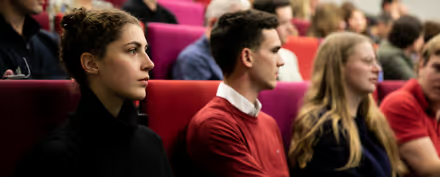Contribute to scientific research and advanced solutions in industrial processes by designing the software and hardware of complex embedded systems in vehicles, pacemakers, chipsets, and other devices.
The design of embedded systems is at the core of technological and industrial progress. Embedded systems are building blocks of medical devices, automobiles, industrial machinery, GPS systems and many other. Even your car’s antilock braking system (ABS) is an embedded system. The design of such systems is crucial for their functionality. If an embedded system can't perform the required task in time with the required quality, this has an immediate effect on the safety of the person. Furthermore, cost- and energy efficiency are crucial. Within the Master’s in Embedded Systems at the University of Twente, you will learn to design, build, and program intelligent software and hardware that comply with strict requirements concerning time latency, power consumption, reliability, and cost efficiency.
In this Master’s, you will learn to tackle the increasing complexity of modern embedded systems by integrating both hardware and software from the early stages of the design process. You will gain the necessary engineering skills and knowledge in embedded artificial intelligence, real-time operating systems, digital hardware design, computer architecture, embedded software development and sensor integration, among others. By the end of the Master’s, you will be able to design embedded systems that meet the desired performance requirements, such as time latency, power consumption, reliability, and cost efficiency. Your skills will be applicable to a wide range of applications, from medical devices and automobiles to industrial machinery and high-performance semiconductor devices.
Combine elements of Computer Science and Electrical Engineering
If you choose the Master’s in Embedded Systems, you will benefit from an exceptional combination of the programmes Computer Science and Electrical Engineering. By integrating computer hardware and software components, you will design, program, and implement efficient embedded systems. The focus is twofold: in addition to learning about embedded AI, microcontrollers, digital signal processing, and sensor integration, you will get to design and develop software that controls the hardware and allows it to communicate with its physical and network environments and with other systems.
Customise your own Master's
You have a lot of freedom to tailor your Master’s to your interests. Whether you are interested in embedded AI, computer architecture, Internet of Things, dependable computing, or cyber-physical systems, you can choose your field of focus by selecting a set of elective courses. This way, you get to shape your learning path.
career perspectives
Embedded systems are an integral part of industrial robots, cars, and magnetic resonance imaging in hospitals, among others, and their demand will only continue to grow. This is why there is an ever-increasing need for embedded systems engineers who can design, develop, test, and maintain embedded systems for time-critical applications such as pacemakers or brake controllers.
As an embedded systems engineer with in-depth knowledge and skills in integrating hardware and software components, you can choose from a lot of career options. You can work at a wide range of companies such as ASML, Philips, Thales, NXP, QBayLogic, Belastingdienst, Benchmark Electronics, Alliander, or Capgemini. You can also opt for a career in academia and do a PhD. Or you can start your own company!
Related programmes
Below you find a list of educational programmes which are (closely) related to Embedded Systems.
Engineering & Technology
Applied Mathematics
Expand your understanding of mathematics to tackle challenging issues in a variety of sectors. This Master’s teaches you to discover new patterns and predict them through mathematical models.
Applied Physics
Deepen your understanding of the laws of physics to find technical solutions in a wide range of areas such as IT, sustainability, healthcare, chiptechnology, digitalisation, finance, space and more.
Biomedical Engineering
Technological advances are at the heart of innovation in healthcare. In this Master's, you'll learn to develop medical innovations that contribute to better care, from organ-on-a-chip to exoskeleton.
Business Information Technology
Become an expert in IT-based business innovation, able to devise new services and radically improve the way businesses work.
Chemical Science & Engineering
Develop new chemical processes, materials and molecules and contribute to innovations that benefit our society in areas such as health, water, food and sustainability.
Civil Engineering & Management
Do you want to work on future-proof solutions in the construction, water and/or transport sector? Learn to manage civil engineering projects with an eye for both technical and non-technical aspects.
Computer Science
Become an expert computer scientist and learn to solve the biggest challenges of our digital society by designing and developing more secure and efficient ICT systems.
Construction Management & Engineering
Become an expert in managing large-scale, complex construction projects in an increasingly digitised industry, using an innovative, integral approach.
Electrical Engineering
Design smart and sustainable electronics and advanced chips for applications such as biomedical technology, autonomous vehicles, computer vision, nanotechnology and the energy transition.
Humanitarian Engineering
Do you want to tackle complex humanitarian crises worldwide? This Master’s helps you develop sustainable, socio-technological solutions to challenges faced by underserved and marginalised communities.
Industrial Design Engineering
Do you want to design innovative products that improve daily life and address today’s challenges? In this Master’s, you combine design and engineering to enhance both products and product development.
Industrial Engineering & Management
Combine technical expertise with management skills to analyse, improve, and future-proof complex business processes in (international) organisations.
Interaction Technology
Delve into the field of human-computer interaction and design and develop intelligent and interactive technologies that are meaningful to people and society.
Mechanical Engineering
Become an expert mechanical engineer who focuses on the futureproof design, analysis and maintenance of machinery, structures, products and production processes.
Nanotechnology
Tackle big challenges on the tiniest scale: become an expert in nanotechnology and develop smart, innovative solutions for major societal issues in healthcare, ICT and sustainability.
Philosophy of Science, Technology & Society
How does technology shape our lives and the world we live in? Learn to understand the role of modern technology in our society from a philosophical perspective.
Robotics
Become an expert in robotics: design smart, human-centred robots and combine AI, mechatronics, systems integration and ethics to make a real impact in industry and society.
Spatial Systems & Society
Natural disasters, poverty, food shortages, epidemics, and climate change: learn to tackle society’s complex challenges through urban design, urban planning, socio-economics insight and spatial data.
Sustainable Energy Technology
Work towards the energy transition! In this Master's, you will learn to conceive, develop and apply sustainable energy solutions for a future without fossil fuels.
Technical Medicine
This Dutch-taught Master's equips you to use AI, medical imaging and smart sensors to improve diagnoses, personalise treatments and safely apply technology in clinical practice.
Information Technology (IT)


